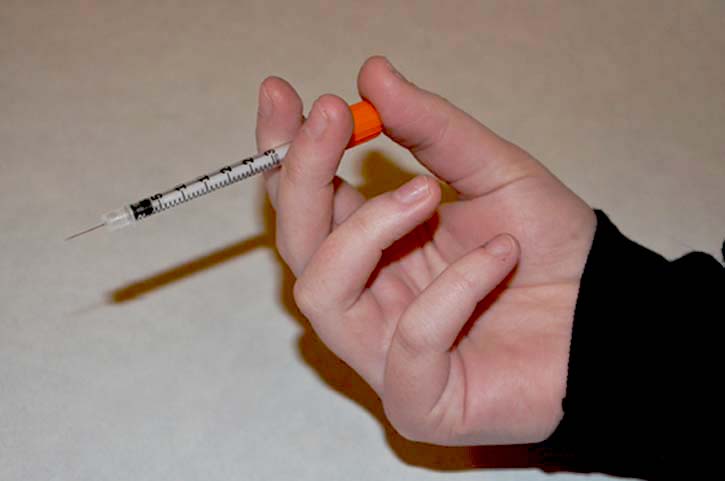Student handles setbacks of diabetes
Junior Aly Bowen holds a needle that is used to give insulin. “I’ve had to give my grandpa shots before, so I’m comfortable using needles,” Bowen said.
March 5, 2014
At the young age of three, junior Sam Thielen was diagnosed with type one diabetes, something that would make her life permanently different. “I got E. coli and my kidneys shut down and then that damaged my pancreas and then that gave me diabetes,” Sam said.
Sam’s mother, Jill Thielen, originally thought that Sam had the stomach flu. However, the E. coli was attacking all of the organs in her body. “When your child becomes ill you never expect it to turn into something more serious,” Jill said. “We had no idea how serious this condition can become and so quickly.”
Sam’s pancreas now will have life-long troubles making insulin, if any at all. People need insulin for their bodies to function, which can be given by a pump or a shot.
“It was heartbreaking as a parent to have to hold your child down (when she was younger) to give her a shot of insulin because all they know is that you are hurting them and they don’t want a shot,” Jill said. “The first few months definitely feel like your whole life revolves around what needs to be done to manage the diabetes.”
Over the summer of 2013, Sam caught the flu. She could feel that it was not like any other flu she had before, and found that it had caused her blood sugar to spiral out of control. “I could feel like something was wrong, so I had my mom take me to the emergency room,” Sam said. “Before we left she had me check for ketones even though I’ve never had them before. I was at the maximum amount the (glucose meter) would show.”
When the blood sugar level reaches 250 or above, it is advised for people with diabetes to check for ketones. Ketones are formed if the body can’t use the blood sugar properly, or if there is not enough carbohydrates to supply the body with glucose and the body begins to break down fat.
“You could tell just by looking at her that there was more going on than just the flu,” Jill said. “When [her blood sugar] was high, checking for ketones was an automatic response.”
Sam’s blood sugar was well over 600 when she was admitted to the hospital. “I was really dehydrated and had to be put on an insulin drip,” Sam said. “The flu made my blood sugar go crazy.” The insulin drip made her blood pressure return to normal, and Sam eventually got over the flu.
At a younger age, Sam’s diabetes wasn’t so easy to manage either. Her parents gave shots of insulin in the morning and at night, which did not control her blood sugar level well. “My parents weren’t there to give me shots (after meals) so I didn’t have insulin after I ate,” Sam said. “In sixth grade I started giving myself shots, so I brought it to the nurse and after lunch I came in to take it.”
Being able to have insulin after each meal has helped stabilize her blood sugar levels throughout the day.
Nurse Susan Krebs needs to know about each student with diabetes, in case she needs to assist a student. “If a diabetic student has high or low blood sugar the doctor will have provided the student and myself with a ‘sliding scale’ for blood sugar levels,” Krebs said. “Depending on how low a student’s blood sugar level is, the student would either drink a juice, chocolate milk, eat some glucose tablets or something with high sugar or carbohydrates in it. Depending on how high a blood sugar level is, the sliding scale would tell us how much insulin would be needed to counteract it.”
However, high school students are usually able to manage diabetes on their own. When Sam is with her friends, she still needs to monitor her blood sugar because there is no off button. “It is important to check the blood sugar level when instructed by the doctor,” Krebs said. “Knowing what to do to manage the highs and lows is key to managing diabetes as well as eating a healthy diet.”
Sam’s friend Aly Bowen knows that having diabetes can be hard, and is able to help if needed. “My grandpa has diabetes so I know how to handle it if something were to happen or if her blood sugar would get too low,” Bowen said. When Bowen and Sam are hanging out, sometimes they need to go get food with high levels of sugar if her blood sugar were to get too low.
Due to the young diagnosis, Sam has adapted to diabetes fairly easily because she has never known anything different. It may have been overwhelming for the Thielen family at first, but it has been worked in to the schedule of their lives and become routine.






